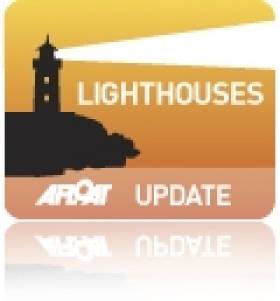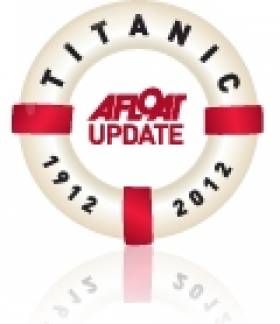Displaying items by tag: tourism
Loop Head Lighthouse To Open On Weekends During September
Clare County Council has announced that Loop Head Lighthouse will remain open to members of the public each weekend during the month of September.
The extension of the opening period follows on from a successful summer season that has seen 15,870 people (12,034 adults, 3,836 children) visit the 19th century landmark building.
Clare County Council, along with Shannon Development, Loop Head Tourism and the Commissioners of Irish Lights (CIL), opened the 19th century lighthouse to the public for the second successive summer season on 18 May last.
According to Ger Dollard, Director of Services, Clare County Council: "Loop Head Lighthouse will close at 5.30 p.m. on 3rd September next. However, we are delighted to be able to open the lighthouse each weekend during September up to the final weekend, which coincides with the Che do Bheatha festival in Kilkee. Opening hours each Saturday and Sunday during September will remain the same as the summer opening hours."
"The lighthouse visitor numbers are extremely encouraging and we look forward to building on this during September," Mr. Dollard added.
Loop Head Lighthouse, located at the mouth of the Shannon Estuary, is steeped in history and rich in maritime heritage with its origins dating back to the 1670s. The existing tower style lighthouse was constructed in 1854 and was operated and maintained by a keeper who lived within the lighthouse compound.
Taoiseach Enda Kenny's grandfather was a keeper at the lighthouse. James John McGinley took up duty at the Lighthouse as Principal Keeper on 16th January 1933. He spent 1 year and 10 months at Loop Head. He was transferred from the station in October 1934. In January 1991, the lighthouse was converted to automatic operation, and today is in the care of an attendant and is also monitored by the CIL.
Maritime & Coastal Tourism Plan to Benefit Ireland
#maritimetourism – The Ireland South MEP Sean Kelly says the strategy, due to be published next year, should prioritise sustainable tourism, taking safety and environmental concerns into consideration. Promoting competitiveness, job creation and benefits for local communities are also pivotal in Mr Kelly's view.
"Ireland may not be able to guarantee year-round sunshine but we have some of the best conditions and resources to attract water sports enthusiasts and general holiday-makers in search of beautiful seascapes.
"Ireland needs to focus on boosting the image and profile of our coastal areas as high-quality destinations. Let's concentrate on the unique appeal ofIrelandand increase tourism. The new EU strategy must support Member States like Ireland in its efforts and that means financial support for SMEs involved in tourism and community grants or regionally diversification of the structural funds," Mr Kelly commented.
The European Commission Directorates-General for Maritime Affairs & Fisheries and for Enterprise & Industry have jointly launched a Public Consultation of individuals and stakeholders to better understand the key challenges and opportunities for the maritime and coastal tourism sectors.
Responses will feed into discussions during this year's European Tourism Day, to be held in Brussels, on September 27th and which will include a dedicated focus on coastal and maritime tourism.
New Giant's Causeway Visitors Centre Opens
#GIANT'S CAUSEWAY - The new Giant's Causeway visitors centre has opened to the public in Co Antrim in what's expected to be a big boost to tourism in the area.
Located close to the UNESCO World Heritage Site, the £18.5 million (€23 million) facility was designed to complement the coastal region's dramatic vistas, with a grass roof that allows it to blend in with the surrounding landscape, and columns that echo the causeway's thousands of naturally formed hexagonal basalt pillars.
As The Irish Times reports, the centre illustrates the story of the stones and the legend of Finn McCool and his Scottish rival who are said to have created the causeway during a mythical battle.
Already and award-winner for innovative design and sustainable features, the National Trust centre - located nine miles from Portrush - looks to welcome up to 780,000 visitors a year.
The Daily Telegraph has images of the new visitors centre and more on the story HERE.
#VOLVO OCEAN RACE – With the last leg now in the final hours before the grand finale of the Volvo Ocean Race in Galway, Minister for Enterprise Richard Bruton yesterday joined Tourism Ireland in the penultimate stopover port of Lorient at a reception for key French and international media contacts.
The event, which took place in the Volvo Ocean Race Village in Lorient, was an opportunity to showcase Galway and Ireland as a fantastic holiday destination – part of Tourism Ireland’s worldwide publicity drive during the race to reach a huge audience of potential holidaymakers.
The Volvo Ocean Race is the third largest sport event globally in 2012, attracting huge publicity around the world – with an estimated two billion people seeing it on TV, reading about it and tuning in to hear about it on the radio.
Since the race kicked off last November from Alicante in Spain, Tourism Ireland has been working in key markets where the race stopped to ensure Galway and Ireland were in the spotlight.
Billy Condon, Tourism Ireland’s manager for southern Europe, said: "The Volvo Ocean Race attracts huge publicity around the world and with Galway set to host the grand finale this week, the stopover here in Lorient was an ideal opportunity to showcase Galway and the west to the international media in attendance, drawing positive attention and publicity for the destination.
"The event is a great ‘hook’ for Tourism Ireland to reach a huge audience of potential French and other international holidaymakers.”
The 2009 stopover of the Volvo Ocean Race in Galway brought 40,500 international visitors to the city, as well as 269 journalists from around the world.
Watersports a Big Attraction on Lough Swilly
#TOURISM - Sailing, kayaking and surfing are just some of the attractions for watersports enthusiasts in Rathmullan, as the Sunday Independent reports.
Sophie Linehan visited the Donegal village on the shores of Lough Swilly ahead of last weekend's second annual SeaFest, which introduced novices to the delights of various aquatic sports.
And it wasn't hard for her to find a whole host of activities for all levels of experience.
Many of these are available at the not-for-profit Rathmullan Sailing and Watersports School, set up by American transplant Rick Le Vert - who 10 years ago had never been sailing himself!
Linehan and her companion were shown the ropes in an afternoon sailing taster session on the lough, which she describes as "the perfect place to learn to sail".
Lessons in surfing and stand-up paddle boarding are also easily availed of - the latter being a great introduction to those who might be a bit scared of the surf.
The Sunday Independent has much more on the story HERE.
Ballycastle's Marine Hotel Finds a Buyer
#TOURISM - BBC News reports that Ballycastle's only major hotel has found a potential buyer 18 months after closing its doors.
The reopening of the Marine Hotel - the sale of which has recently been agreed - could be a needed lift for the economy of the Co Antrim town.
"The closure of the hotel was a major blow to the town's economy," said the BBC, "as the Marine not only catered for tourists, but many local clubs and sporting organisations used its function rooms for meetings and events."
The property went into receivership in May last year after the bankruptcy of its then owner, developer Mervyn McAlister.
The Marine's reopening - which could be as soon as the end of this summer - would be an extra boost to marine tourism facilities on the North coast, following the opening of Portnagree House, Harbour and Marina Visitor Centre in Ballycastle harbour earlier this year.
New Harbour Charges Could End Trips to See Fungie
#IRISH HARBOURS - "Draconian" new charges for harbour users could bring an end to boat trips to see Dingle's most famous resident, according to The Irish Times.
Fungie the dolphin has been a mainstay of Dingle harbour for almost 30 years, but boat trips to visit him could cease to operate "with immediate effect" if charges of up to €9,000 are imposed "in advance" of the season.
Currently operators in the Dingle Boatmen's Association pay around €2,500 to use the harbour at the end of each season.
Association chairman Jimmy Flannery called on anyone working in tourism in Ireland to make submissions to the public consultation before the deadline next Friday 20 April.
As previously reported on Afloat.ie, yacht owners are also up in arms over the new charges proposed by Marine Minister Simon Coveney that could see their rates hiked by an incredible 800 per cent.
And the news comes not long after fellow Kerry harbour users protested proposed new bylaws to regulate their activities and impose new charges.
Kerry Harbour Users Say No to Over-Regulation
#IRISH HARBOURS - Protesters took to the water off Kerry's piers last month in an organised swim drawing attention to proposed harbour bylaws designed to regulate the activities of water users.
“We need to make the public aware they have to make submissions,” Denise Collins told The Irish Times from Kells, which hosted one of the largest swims. “Traditional activities such as swimming will be over-regulated, we fear.”
The proposed bylaws would give Kerry County Council greater control over 16 of the county's 57 harbours and piers, including Kells, Kenmare, Portmagee, Brandon and Ventry.
Under the new bylaws, strict regulations would be placed on the use of loudhailers, landing and unloading passengers and freight, waste and even movement around the harbour.
"Draconian" charges are also set to be imposed on fishermen and other harbour users, while campaingers also feel that a ban on swimming and diving could also be added to the list.
The proposed bylaws already suffered a set-back earlier this year when Kerry County Councillors decided to restart the consultation process to allow the fishing industry, tourism operators and other interests more time to make submissions.
According to the Irish Examiner, only two submissions had been received by the council as of its January monthly meeting, despite senior council officials working for months on the draft proposals.
Cllr Toiréasa Ferris commented that the proposed charges in particular "would have huge implications for fishermen, some of whom might currently be earning only between €40 and €50 for a 14-hour day."
As previously reported on Afloat.ie, charges may also soon be hiked on yachts berthing at Ireland's main fishing harbours, a list that includes Dingle in Co Kerry.
Irish Marine Federation chairman David O'Brien expressed concern at the potential for such charges to damage "the good tourism dividend for coastal towns", noting that for every euro spent on a harbour berth, €10 was normally spent in the locality.
#GALWAY HARBOUR - Galway Harbour management are looking forward to the prospect of Chinese investment in the port's redevelopment plans, the Galway Independent reports.
“Chinese investors clearly recognise not only the massive potential of ocean tourism, but also the specific potential for Galway as a destination port for cruise liners," said Fine Gael TD Brian Walsh, referring to discussions between the Government and Chinese officials in Beijing last week.
As previously reported on Afloat.ie, Galway Bay can expect to welcome at least nine cruise visits thus year, with the first scheduled to arrive late next month.
Walsh added: "Galway is an incredibly attractive city, and if we can make it accessible to the major players in the cruise-line market, the impact on the local economy would be immense.”
Galway Harbour Company CEO Eamon Bradshaw said that the port project had "illicited quite a bit of interest" when the company presented at the recent Chinese-Ireland Relations conference at NUI Galway.
"We’re confident that we do have a lot to offer and we are confident that an investor will come on board."
The Galway Independent has more on the story HERE.
#TITANIC - A Belfast man who saw the Titanic launch from the Harland and Wolff shipyards more than 100 years ago was guest of honour at the opening of Titanic Belfast at the weekend.
"It's like our Sydney Opera House," 105-year-old Cyril Quigley told BBC News of the £97 million (€116.7 million) visitor centre, opened on the 100th anniversary of the infamous ocean liner's tragic demise.
"My father and mother took me to Workman and Clark shipyard which is on the opposite side [of Belfast Lough] to watch the launch," he recalled to the Belfast Telegraph.
"I just saw a mass of metal in the gantries that they built for it and all I saw was this big thing sliding out into the water. I was only four-and-a-half."
Quigley described the new facility - designed to echo the imposing bow of the Titanic - as "wonderful", a sentiment echoed by Belfast Lord Mayor Niall O'Donnghaile who said: "The Titanic belongs to Belfast but this spectacle - Titanic Belfast - belongs to the world."
First Minister Peter Robinson was joined by Deputy First Minister Martin McGuinness at the ribbon cutting ceremony on Saturday 31 March, with the former declaring that this is "a new era in this province".
Titanic Belfast is expected to attract more than 400,000 visitors in its first year, and some 100,000 people have already purchased tickets. It will also be one of the largest employers and recruiters in Northern Ireland's tourism industry, as previously reported on Afloat.ie.
But the public's reaction so far has been mixed, according to The Irish Times, with some expressing disappointment at the lack of any large-scale model of the ship, and that the replica of the ship's famous staircase is hidden from public view in the venue's banqueting hall.






































































